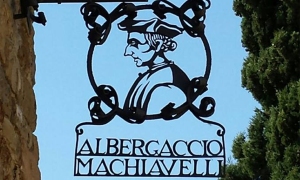In my Summer 2014 CSU-Italy Study Abroad trip, one of our classes is COMM 4555: Machiavellian Principles in Communication which pertains to Niccolo Machiavelli and how his works apply to Communication-Public Relations. Of course, the moment I heard Machiavelli was a part of this Study Abroad trip to Italy I knew I would be going because of an earlier Spring Semester 2013 ITDS 5555U Interdisciplinary Special Topics class. It should be known my fellow students and I quickly coined this Interdisciplinary class as ‘Great Books.’ Among these great books was Niccolo Machiavelli’s 16th-century political treatise “The Prince.” This political treatise is now called the handbook/playbook for statesmen in modern times. I found Machiavelli’s insight and genius to be awe-inspiring. Thus, after visiting his childhood/family home and the city of Siena, my personal admiration for Machiavelli, his political philosophy, and what has been deemed as his resume to the Medici Family has grown exponentially. This admiration is further increased after personally seeing the actual table and chair from which Machiavelli’s great political treatise was penned. However, this Study Abroad trip is making the influences upon Machiavelli’s writing of “The Prince” clearer.
Machiavelli’s “The Prince” was penned following his dismissal from government involvement once the Medici family was reinstalled to power. However, he was only dismissed and exiled after his name was discovered on a scrape of paper carried by a conspirator involved in an alleged assassination plot against the Medici family. Machiavelli was arrested on suspicion. He was tortured and jailed for a few weeks until his innocence was established. Nevertheless, he was exiled to live on his family farm miles from Florence. For the rest of his life he wrote and dreamed of returning to public and political life in Florence. He had a view of Florence and its seat of government from the hills of his family’s farm. This exile, in itself, added further insult to the injury of being removed from the job he loved, the excitement politics gave him, and in trying to redeem his family legacy.
The discovery and realization Machiavelli has ties to Siena and the Allegory of Good and Bad Government through the ruler of Siena, Pandolfo Petrucci, makes the writing of “The Prince” make even more sense. The Allegory of Good and Bad Government should be included in the influence of Machiavelli’s writing of “The Prince” because one side of the room pertains to what good government is like and how it affects the lives of the people. The other side of the room pertains to bad government and how it affects the lives of the people. The Allegory is in the Sala dei Nove (Salon of Nine or Council Room) in the Palazzo Pubblico (or Town Hall) of the city of Siena, Italy. In acknowledging, “The Prince” is the handbook for princes and/or for modern statesmen to keep and maintain control of power of city-state, government, or country, it can be intelligently assumed Machiavelli saw the Allegory of Good and Bad Government when visiting the Palazzo Pubblico in Siena. Therefore, these symbolic civic paintings understandably had influence upon Machiavelli. Along with his experience as a civil servant, his research, and interest in the history of the Roman Empire (which led to his writing of the “Discourses on Livy”), the Allegory of Good and Bad Government also gave Machiavelli the spark to write “The Prince” while in exile. In conclusion, the influences upon Machiavelli’s writing of his political treatise are wide and varied, but without these influences and his exile from Florence, it is possible to conceive that Machiavelli’s legacy would not have lived on.
